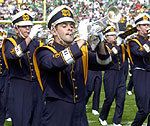Oct. 1, 2004
By Lisa Credo ’05
Senior, Baritone
Kenner, Louisiana
The smoky aroma of barbeque grills and the fresh smell of campus trees and flowers mingle in the air. The bells of the Basilica echo through the quad and you feel a light breeze as amber, rust, and crimson colored leaves float lazily to the ground. The shimmering reflection of the sun on the lake near the Grotto catches your eye. You hear the distant rumble of drums, and your heart begins to beat faster as the drumming grows closer. Suddenly, the famous opening line “Cheer, cheer for ol’ Notre Dame!” fills the quad, and hundreds of Irish fans burst into cheers as the Band of the Fighting Irish marches through campus towards the stadium. As the band advances, a sense of excitement spreads through the campus. The crowd claps along and many sing as the band plays the legendary “Notre Dame Victory March.”
The “Victory March” has been played to celebrate National Championships. It has been played to rally players and fans through games. It has encouraged American soldiers on the front lines. It has been featured at White House parties, in flea circuses, and everywhere in between. Band members estimate that they play it over 4,000 times each year.
For a song that has become so legendary, the “Notre Dame Victory March” had an unlikely beginning. In fact, the song’s composers would probably be surprised to learn what popularity it has gained since its creation nearly a century ago. The original melody was actually written by two Notre Dame graduates, brothers John and Fr. Michael Shea. They intended the song to be merely an example and hoped it would encourage students to eventually write something better. The brothers never imagined that “The Victory March” would gain such fame.
Much of the song’s success is attributed to Joseph Casasanta. As Notre Dame Band Director from 1919 to 1943, Casasanta arranged the modern version of the song, and is also credited with the creation of “Notre Dame, Our Mother,” which was originally played at Knute Rockne’s funeral. Casasanta composed traditional school songs such as “Hike, Notre Dame,” “On Down the Line,” and “When Irish Backs Go Marching By,” tributes to Irish quarterbacks, linemen, and backfields, respectively.
Robert O’Brien, Director of the Band from 1952-1986, later wrote arrangements of all of Casasanta’s pieces, as well as the selection of Tchaikovsky’s 1812 Overture which has become known to fans as “The Lou Chant”. Many of O’Brien’s own compositions have also become part of Irish tradition, most notably “Damsha Bua,” commonly called “The Victory Clog.” The Irish Guard performs a dance to this lively jig on game days when Notre Dame is victorious.
All of these songs have become part of the Notre Dame tradition. Each time they are played, the legacy lives on and the tradition is perpetuated. Over time, they have become sacred; their tunes stir up something deep inside Irish fans not only because of their own rich tradition, but also because of the Spirit they represent, the Spirit of Notre Dame. So sing along, and cheer the Irish “onward to victory!”







